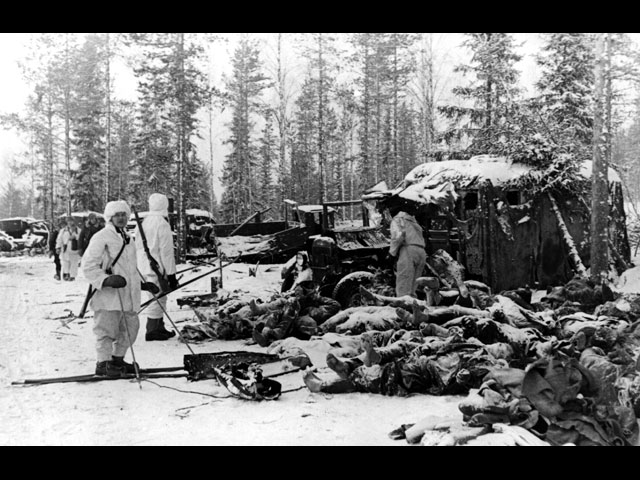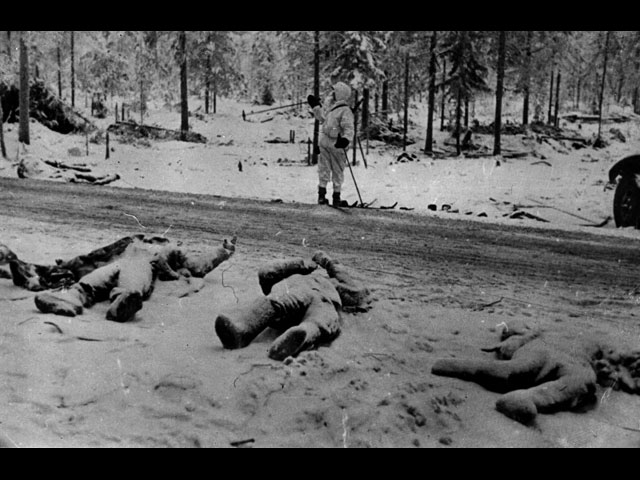Monday 8 January 1940
 |
| Soviet dead stacked up near their abandoned vehicles. |
Winter War Army Operations: The Soviet holdouts on the Ratte road surrender around Lakes Kuivasjarvi and Kuomasjarvi (near Captain Mäkinen’s original roadblock). The Finns will take a few days to finish off the remaining Soviet stragglers who ran into the woods or are still hiding in abandoned equipment on the Ratte road. In essence, though, they now have completely eliminated what had been considered the most dangerous advance into the country.
Casualties of the 44th Rifle Division totaled over 5,000 men. All told, in the Suomussalmi battles, the Soviets lost 13,000-27,500 dead or missing, with 2,100 prisoners, 71 field guns, 260 trucks, 1,170 horses, 29 anti-tank guns, and 43 tanks captured.
While it is an epic defeat, the Soviet Union is far from defeated.
 |
| A Wellington bomber with the DWI apparatus. |
Operating from Manston, Kent, England, must fly low (60 feet) and slow. If it flies lower than 35 feet, it risks damage from the exploding mines. It makes its first sortie over the North Sea. This is one solution to the magnetic mines, the other is degaussing of individual ships, but that will take longer to implement and is much more costly.
Convoy HG 14 departs from Finland to Liverpool.
British Homefront: Weekly British food rationing begins and ration books are issued. Every person gets 40z (100g) of back or ham, 12z (350g) of sugar.
German Military: The Germans establish a new military headquarters at Recklinghausen about 10 miles from the Dutch frontier.
British Military: General Wavell departs for an inspection tour of British Somaliland and French Somaliland.
Japan: The Japanese cabinet establishes a puppet government over occupied China. It is headed by Ching-Wei, who previously had lost a power struggle with Chiang Kai-shek for control of the Nationalist government and now seeks to control China by another route.
China: The Chinese Winter Offensive grinds on: Southern Honan Army of the 5th War Area launches a counterattack around the Pingchangkuan - Hsiaolintien - Kungchiafan sector.
 |
| A Soviet POW. |
January 1940
January 1, 1940: Finns Carve up the SovietsJanuary 2, 1940: Finnish Counterattacks Continue
January 3, 1940: Soviets Trapped
January 4, 1940: Soviet Breakout Attempts Fail
January 5, 1940: Dicing Up the Soviets
January 6, 1940: Soviet 44th Division Runs
January 7, 1940: Shakeup in Soviet High Command
January 8, 1940: Ratte Road Battle Ends
January 9, 1940: British Submarines in Peril
January 10, 1940: Mechelen Incident
January 11, 1940: Finns Surround More Soviets
January 12, 1940: New Soviet Attacks at Taipale
January 13, 1940: Fall Gelb Postponed
January 14, 1940: Japan's Government Falls
January 15, 1940: Soviets Prepare More Carefully
January 16, 1940: German Atrocities Uncovered
January 17, 1940: Bletchley Park in Action
January 18, 1940: New Hope for Allied Shipping
January 19, 1940: Finnish Attacks at Salla
January 20, 1940: Churchill Urges Cooperation
January 21, 1940: Asam Maru Incident
January 22, 1940: Dissension Within British Government
January 23, 1940: Dissension in South Africa
January 24, 1940: NKVD Blocking Detachments
January 25, 1940: Auschwitz Site Selected
January 26, 1940: Millionaire Bunker Destroyed
January 27, 1940: U-20 Sinks Four Ships
January 28, 1940: Softening Up the Finns
January 29, 1940: Moscow Willing to Talk
January 30, 1940: Hitler Throws Down the Gauntlet
January 31, 1940: Timoshenko Is Ready
2019

















